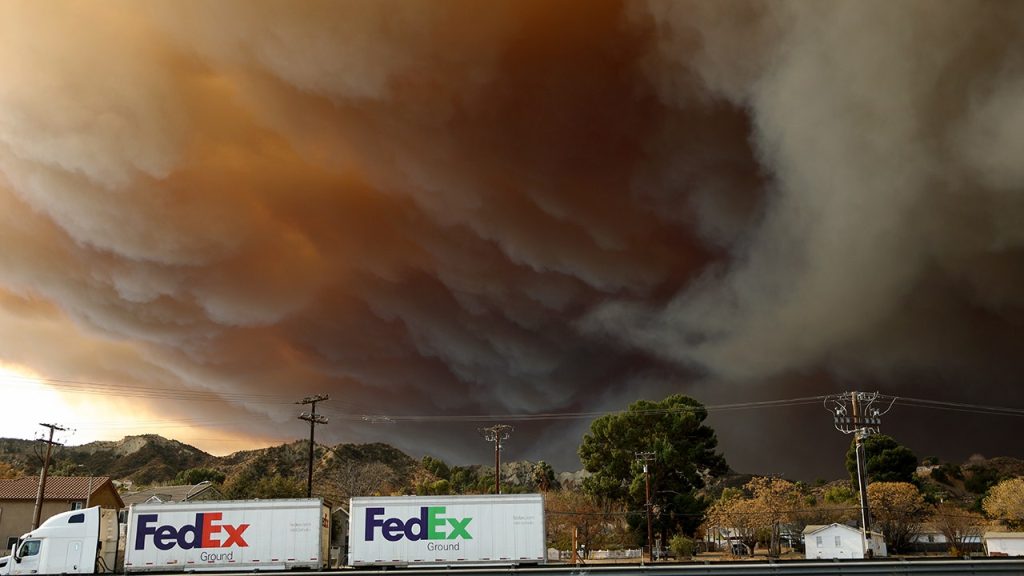The Hughes Fire, a rapidly spreading wildfire, ignited in the unincorporated community of Castaic, Los Angeles County, on Wednesday morning, triggering immediate evacuation orders for residents in several surrounding areas. Within hours of its eruption, the fire had consumed over 5,000 acres, demonstrating its aggressive nature and posing a significant threat to life and property. Plumes of smoke billowed ominously near Castaic Lake, a reservoir nestled in the Sierra Pelona Mountains, painting a stark picture of the unfolding disaster. The fire’s rapid growth and the issuance of mandatory evacuation orders underscore the gravity of the situation and the urgent need for residents to heed official warnings.
The Hughes Fire adds another layer of complexity to an already devastating wildfire season in California. Firefighters have been tirelessly battling multiple blazes across the state, most notably the destructive Pacific Palisades fire, which began earlier in January and has tragically claimed at least 11 lives and destroyed over 6,500 structures. This series of wildfires underscores the increasing vulnerability of California’s landscape to these destructive events, likely fueled by a combination of factors such as dry vegetation, strong winds, and rising temperatures. The cumulative impact of these fires is putting a strain on resources and highlighting the urgent need for improved fire prevention and management strategies.
California authorities, including Cal Fire, have issued mandatory evacuation orders for residents in four zones near the Hughes Fire, encompassing areas around Castaic Lake, Paradise Ranch, and the Ridge Route. These orders emphasize the immediate threat to life and safety, urging residents to leave their homes without delay. The affected areas have been legally closed to public access to facilitate firefighting efforts and ensure the safety of both residents and emergency personnel. The severity of the situation is further emphasized by the clear and direct language of the evacuation alert, leaving no room for ambiguity.
While residents in certain areas are under mandatory evacuation orders, other nearby communities have received evacuation warnings, indicating a potential threat that requires close monitoring and preparedness. These areas include the vicinity of Charlie Canyon, Sloan Canyon, Green Hill Drive, and Bitter Canyon. Residents in these warned areas are strongly advised to gather essential belongings, prepare for potential evacuation, and stay informed about the evolving situation. This tiered approach to evacuation alerts allows authorities to prioritize the most imminent threats while also preparing residents in potentially affected areas for swift action if necessary.
The Los Angeles County Fire Department is at the forefront of the battle against the Hughes Fire, working tirelessly to contain the blaze and protect lives and properties. They are deploying various resources, including ground crews, aerial support, and specialized equipment, to combat the fire’s spread. The challenging terrain and dry conditions are likely hindering firefighting efforts, making it crucial for residents to cooperate with evacuation orders and avoid putting themselves or emergency personnel at further risk. The ongoing fight against the Hughes Fire highlights the dedication and bravery of firefighters in the face of dangerous and unpredictable conditions.
The Hughes Fire serves as a stark reminder of the ever-present threat of wildfires in California and the importance of preparedness. Residents are encouraged to regularly monitor official sources of information, such as the Cal Fire website, for updates on evacuation orders and fire conditions. Creating defensible space around homes, having an emergency plan in place, and being aware of evacuation routes are crucial steps in mitigating the risks associated with wildfires. The Hughes Fire underscores the need for continued vigilance and proactive measures to protect lives and properties in fire-prone areas. It also highlights the importance of community support and cooperation during such emergencies.

